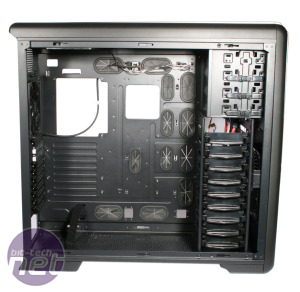
Once we’d pulled off the side panel, we could finally get a good look at the cavernous interior. The entire shell is painted black, with an almost excessive twelve cable management holes, fitted with rubber grommets, to help keep the interior free of loose wires.
Two CPU cut-outs make it easy to install or replace heat sink backing plates, even if you’re using an HPTX motherboard, although without a cover for the second CPU cut-out, it will poke out from behind a standard ATX board. There’s around 20-25mm of clearance behind the motherboard tray, which should be more then enough to hide away the majority of your cables. One negative though is that Enermax doesn’t include an 8-pin ESP12V ATX extension in the box – our power supply's wasn’t long enough to route around the back of the motherboard tray by itself, meaning you’ll have to buy one unless you’ve got an extraordinarily long 8-pin cable.


Click to enlarge - Enermax has likely used the same OEM manufactuerer as Xigmatek's Elysium, so both share a very similar, spacious internal layout.
A hard disk drive cage at the front of the case is oriented sideways, letting you slot in additional disks with minimal effort, although you’ll still need to remove the right side panel to get them connected. The ten disk trays can be pulled out without any tools, but you’ll need a screwdriver to secure a disk in place. The cage itself is also riveted in place, meaning you can’t remove it without the aid of a drill. This could be a problem if you want to mount a 2x140mm radiator on the front intake, as there’s not a lot of clearance, but isn't an issue for extra long graphics cards. There’s a massive 42cm of clearance, which should be plenty for even the most high-powered cards. This shrinks if you install fans on the inside of the hard disk cage – there are mounts for two 140mm fans if you plan on installing a lot of disks.
If you’re sticking with air cooling, you can connect one additional fan to the internal fan controller. It’s powered by a single molex, with a separate control board for the Vegas fan LED controls. It’s fairly small, but we would still have preferred it if it was located on the rear, to keep cable management under control. However, there are mounts at the bottom of the case in should you want to relocate it.
If you’re going down the liquid cooled route, you’ll be impressed with the range of options available in the Fulmo GT. There’s enough room for a 3x140mm fan water-cooling radiators in either the top or bottom of the case, although the multiple PSU mounts mean you can only install one such radiator, not both. Taking PSU length into account will also limit you to either a 2x140mm or even 1x140mm setup, although there’s still enough clearance for a push-pull configuration in the roof if you’re using an ATX motherboard.
Two CPU cut-outs make it easy to install or replace heat sink backing plates, even if you’re using an HPTX motherboard, although without a cover for the second CPU cut-out, it will poke out from behind a standard ATX board. There’s around 20-25mm of clearance behind the motherboard tray, which should be more then enough to hide away the majority of your cables. One negative though is that Enermax doesn’t include an 8-pin ESP12V ATX extension in the box – our power supply's wasn’t long enough to route around the back of the motherboard tray by itself, meaning you’ll have to buy one unless you’ve got an extraordinarily long 8-pin cable.


Click to enlarge - Enermax has likely used the same OEM manufactuerer as Xigmatek's Elysium, so both share a very similar, spacious internal layout.
A hard disk drive cage at the front of the case is oriented sideways, letting you slot in additional disks with minimal effort, although you’ll still need to remove the right side panel to get them connected. The ten disk trays can be pulled out without any tools, but you’ll need a screwdriver to secure a disk in place. The cage itself is also riveted in place, meaning you can’t remove it without the aid of a drill. This could be a problem if you want to mount a 2x140mm radiator on the front intake, as there’s not a lot of clearance, but isn't an issue for extra long graphics cards. There’s a massive 42cm of clearance, which should be plenty for even the most high-powered cards. This shrinks if you install fans on the inside of the hard disk cage – there are mounts for two 140mm fans if you plan on installing a lot of disks.
If you’re sticking with air cooling, you can connect one additional fan to the internal fan controller. It’s powered by a single molex, with a separate control board for the Vegas fan LED controls. It’s fairly small, but we would still have preferred it if it was located on the rear, to keep cable management under control. However, there are mounts at the bottom of the case in should you want to relocate it.
If you’re going down the liquid cooled route, you’ll be impressed with the range of options available in the Fulmo GT. There’s enough room for a 3x140mm fan water-cooling radiators in either the top or bottom of the case, although the multiple PSU mounts mean you can only install one such radiator, not both. Taking PSU length into account will also limit you to either a 2x140mm or even 1x140mm setup, although there’s still enough clearance for a push-pull configuration in the roof if you’re using an ATX motherboard.

MSI MPG Velox 100R Chassis Review
October 14 2021 | 15:04








Want to comment? Please log in.